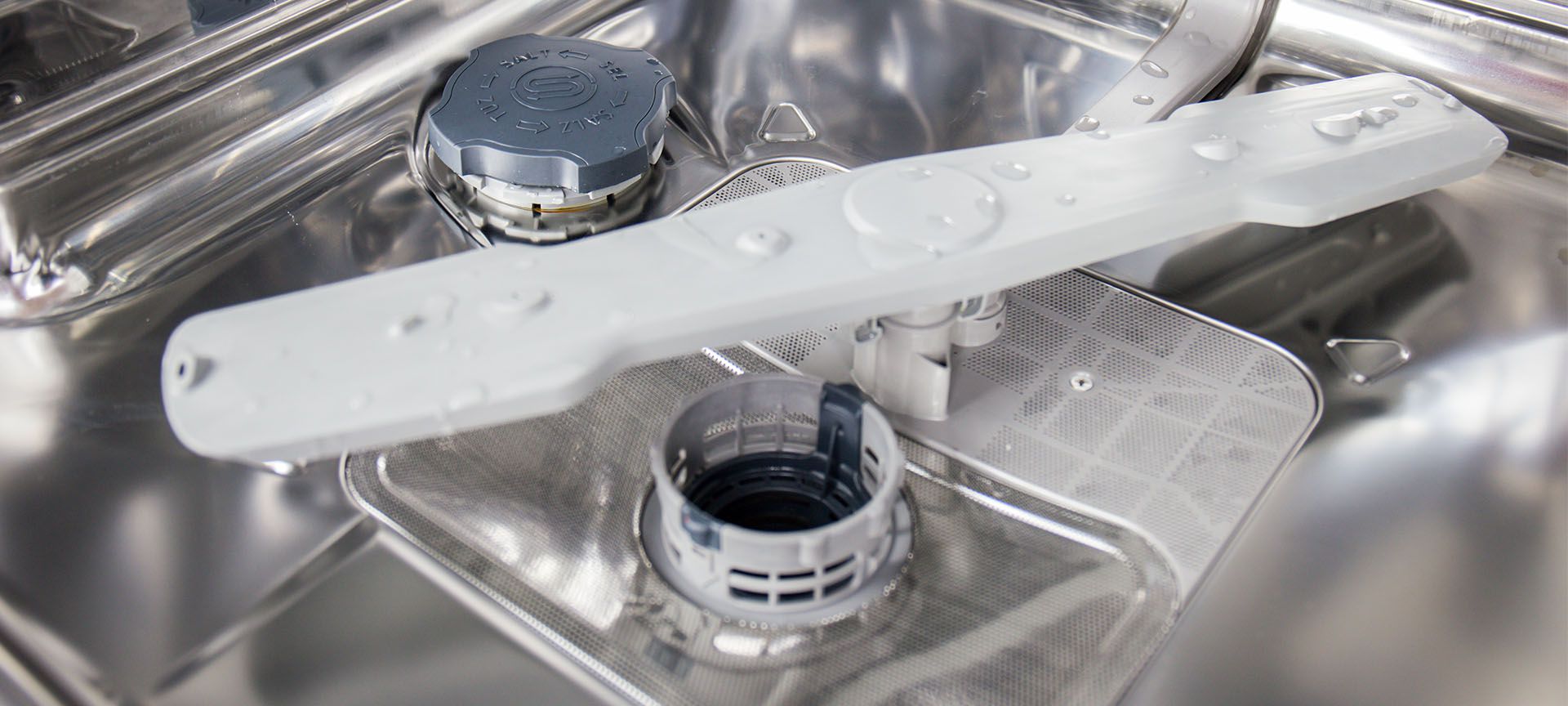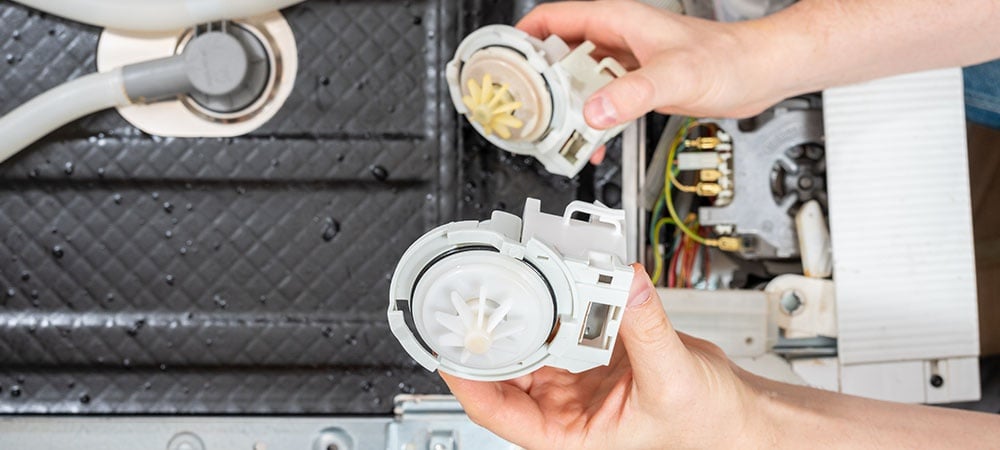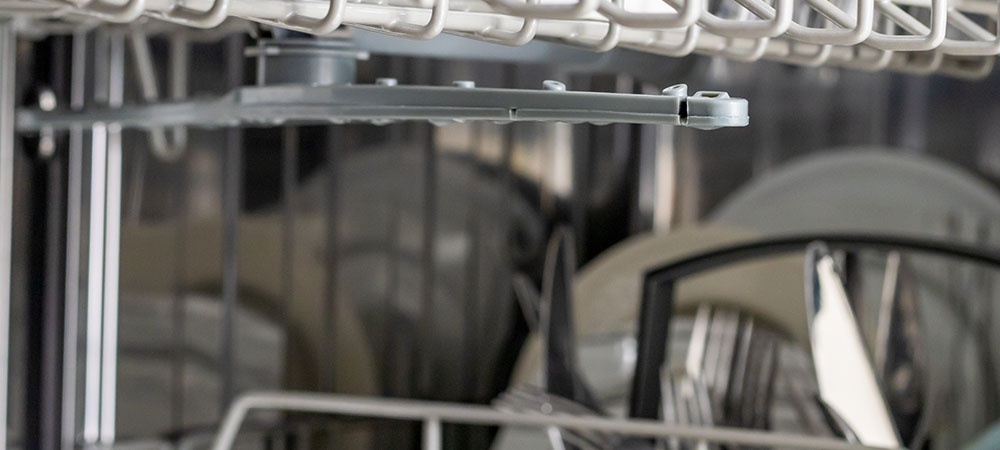A dishwasher not draining properly completely alters the device’s usefulness. You might as well wash the dishes by hand if you have to drain water manually after or before a dishwasher wash.
You can fix a dishwasher that’s not draining correctly in less than one hour. It all depends on where the fault is and the tools at your disposal.
Calling an expert is usually the best option. But before that, there are some checks and fixes to try on your own.
This article will explain why your dishwasher won’t drain and the corresponding DIY solutions. Get your toolbox, and let’s figure out your dishwasher’s problem!
Why Dishwasher Won’t Drain and How to Fix it
The common culprits to check if your dishwasher is not draining include:
Garbage Disposal
Most dishwasher designs merge with the home’s existing plumbing system. That means the dishwasher drains through the garbage disposal of the closest sink.
Your dishwasher will not drain if the garbage drain has food clogs blocking its path.
Solution
If the garbage disposal is the problem, turn it on. If you do this for about sixty seconds, it will clear the pathway.
The garbage disposal may need manual cleaning, especially if you don’t run it regularly. You may need to pour hot water down the disposal or vinegar to clear the path.
After clearing the garbage disposal, run your dishwasher and check if it leaks. Also, remember to run your garbage disposal frequently to avoid recurrence.
The Filter
The device’s filter may be why you need to unclog your dishwasher. The filter ensures water flowing during the wash cycle is free of food particles and contaminants.
The filter can get clogged with the food items over time, causing standing water in the dishwasher.
Solution
The only solution necessary is to clean or change the filter. The first step, however, is determining the filter’s location.
Most dishwashers have filters at the bottom, but some models fix it below the spray arm or at the back. Checking your user guide for the filter location is usually the best option.
Cleaning the filter is easy. Use a toothbrush and detergent to scrub it softly. The filter needs a replacement if cleaning it doesn’t fix the standing water issue.
It’s always better to have a dishwasher repair technician replace it because of the complexities. But if you have some basic experience, you can do it if you buy the right replacement.
Drain Pump
The drain pump is yet another culprit to suspect when you need to unblock a dishwasher.
The drain pump is the compartment that directs water out of the dishwasher. The pump can get dirty with food clogs and other particles. And this dirt will hinder the pump from performing its function.
Likewise, the pump may have certain faults mechanically or electronically, hindering it from performing optimally. Usually, when there’s a problem with the pump, it will make struggling sounds.
Solution
The drain pump in most dishwashers is at the bottom. But check your user guide to confirm its location.
- Once you can access the pump, check for clogs and clean appropriately. Be careful; some broken glass and other sharp objects may be present.
- You must check for an electrical or mechanical fault if you only notice minor clogs.
- You’ll need a multimeter to check if the pump is functioning well. If the multimeter reading discovers a problem, the pump will need replacement. Again, have an expert buy and replace it to avoid errors.
Drain Hose
The drain hose is the connection taking water out of the dishwasher. It either connects the dishwasher to the air gap or garbage disposal.
Usually, the hose is a corrugated plastic tube, prone to bending and cracks. The drain hose can also get clogged with food particles and oil.
Solution
It’s usually easy to locate the drain hose since it extends from the dishwasher to the disposal or drain. But before you think of how to unblock the dishwasher hose, check its position first.
- The plastic hose can fold in a position that hinders water flow, causing the water to return to the dishwasher. Repositioning the drain hose is usually the solution.
- If the hose’s positioning is okay, you may need to remove it to clean the debris. But before that, try pouring a mix of baking soda, vinegar, and hot water into the drain. If it works, you don’t have to remove it.
- If not, remove the drain hose and clean it appropriately. Prepare for water held within the hose before removing it.
Drain Valve and Valve Bracket
Not all dishwashers have a drain valve or valve bracket. If yours has, it may be why your dishwasher isn’t draining.
Confirm if the valve works well by pushing the valve bracket and monitoring its movements. If it’s stiff, the drain valve may be the problem.
Solution
The dishwasher’s drain valve operates electromagnetically through a solenoid. Also, it has a motor that works in a single or reversible direction. A faulty valve requires replacement with the help of an appliance repair expert.
Related Article: How To Troubleshoot A Dishwasher
Air Gap or High Loop
Dishwashers have two draining techniques, regardless of the draining destination. It’s either the air gap or high loop connection that leads to the garbage disposal or drain.
The air gap connection is a small cylinder device made of plastic, usually around the sink. It stops air vacuum formation and prevents water from going back. Sometimes, this air gap gets dirty with clogs and stains.
The dishwasher hose loops to connect to the garbage disposal or drain if it’s the high loop connection. Sometimes, the loop may loosen up, and the dishwasher will not drain because of the height changes.
Solution
For a high loop connection, fix the loop so water can slope easily. If it’s the air gap connection, you’ll need to remove it and clean it inside the item.
Spray Arms
The spray arm is the compartment that sprays water on the plates during a washing cycle. The holes that spray water can get blocked by food particles, hindering water flow and causing standing water.
The only solution is to clean the spray arm thoroughly. If the debris proves stubborn, you can remove it and use vinegar and baking soda to dissolve them.
Can I Run My Dishwasher with Standing water?
No, you can’t run your dishwasher with standing water in it. Standing water in your dishes gives breeding room for bacteria and can damage the dishes.
It can also spoil the dishwasher as a whole. If you must use the dishwasher, drain the standing water manually before and after the wash.
Related Article: Tips for DIY Dishwasher Repair
What to Do When Your Dishwasher Doesn’t Drain
Your dishwasher not draining can have many causes. However, the most likely cause is around the drain, drain pump, disposal, and hose. If you check these compartments and they’re good, maybe you need to call an expert.
At Prime Appliance Repairs, our technicians have the training and experience to fix the dishwasher not draining. They’ll also find and discover potential problems with your device.
Call 647-905-7302 for our same-day dishwasher repair services for residents in Ontario.











